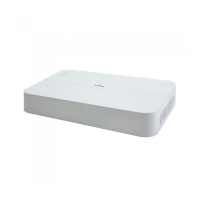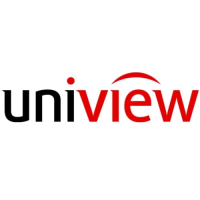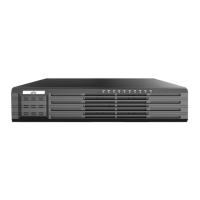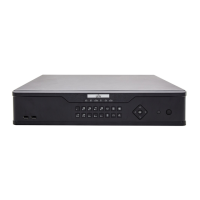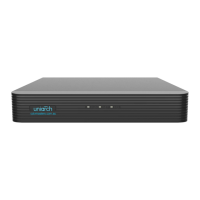Do you have a question about the UNIVIEW nvr201-08lp and is the answer not in the manual?
Covers initial setup steps, login procedures, and mouse operations for the NVR.
Details on accessing the NVR system using default credentials and security recommendations.
Explains how to use the mouse for various operations within the NVR interface.
Guides through the initial setup process, including preparation and startup wizard for the NVR.
Covers viewing live camera feeds, status icons, toolbars, and image settings within the NVR interface.
Explains the meaning of various icons displayed in the camera preview window.
Details the functions and buttons available on the preview window toolbar for camera control.
Guides on adjusting image parameters like contrast, hue, saturation, and brightness for optimal viewing.
Explains how to set up camera views, screen layouts, and auto-switch settings in the preview.
Covers managing IP cameras, adding devices, OSD, image settings, and privacy masks for NVR setup.
Details on how to add, edit, and delete IP cameras and manage their connection status.
Instructions for configuring On-Screen Display (OSD) elements like date, time, and camera names.
Guides on adjusting image parameters like contrast, hue, saturation, and brightness for cameras.
Guides on setting up privacy masks to block specific areas in the camera's field of view.
Explains how to control Pan, Tilt, and Zoom (PTZ) cameras, including presets and patrol routes.
Describes the functions of the PTZ control toolbar for operating PTZ-enabled cameras.
Steps to save and recall specific camera positions (presets) for PTZ cameras.
Covers video recording settings, including encoding, scheduling, motion detection, and alarm triggers.
Details on configuring video encoding parameters such as resolution, bitrate, and frame rate.
Explains how to set up time-based recording schedules for cameras.
Guides on enabling and configuring motion detection for triggering recordings.
Instructions for setting up recordings based on external alarm inputs.
Covers how to initiate and stop video recording manually.
Information on managing the NVR's hard disk drives, including formatting and properties.
Covers various methods for playing back recorded video, including instant, by date, tag, event, and smart search.
Quickly playing back the most recent video recordings directly from the preview window.
Detailed instructions for retrieving and playing back recordings by selecting specific cameras and dates.
How to use tags to mark and search for specific events or time points in recordings.
Searching and playing back recordings based on specific event types like motion detection or alarms.
Utilizing smart search features to efficiently review recordings containing specific results like detected motions.
Playing back video recordings stored on external devices like USB drives.
Covers backing up recorded video, clips, and images to external storage devices.
Procedure for backing up recorded video footage from the NVR's hard disk to a USB storage device.
Steps for performing a standard backup of selected recordings by date and time.
Instructions for backing up still images (snapshots) from the NVR to external storage.
Configuration and management of alarm inputs, outputs, motion detection, tampering, video loss, and alerts.
Setting up and configuring alarm inputs and outputs, including trigger actions and arming schedules.
Enabling and configuring motion detection parameters and associated trigger actions.
Setting up and configuring detection for camera lens tampering events.
Configuring alerts and actions for when a video signal from a camera is lost.
Managing system alerts for events like storage errors, disk issues, illegal access, and network disconnections.
Defining actions to be performed when an alarm event occurs, such as buzzer, email, or recording.
Guides on setting up network parameters for NVR connectivity, including basic settings, PPPoE, DDNS, and IP control.
Configuring fundamental network settings like IP address, subnet mask, and gateway for NVR operation.
Setting up Point-to-Point Protocol over Ethernet (PPPoE) for internet access.
Instructions for enabling and configuring the NVR's cloud connectivity service for remote access.
Configuring Dynamic DNS (DDNS) to access the NVR via a domain name.
Details on configuring network ports for NVR services like HTTP, RTSP, and SDK.
Setting up port mapping using UPnP or manual methods for external network access.
Configuring email alerts and notifications for events detected by the NVR.
Setting up IP address filtering (Blacklist/Whitelist) to control access to the NVR.
Covers basic system settings, time configuration, DST, serial port settings, and user management.
Configuring general system parameters such as device name, language, and auto-logout.
Setting the NVR's time zone, date, and time formats, including NTP synchronization.
Managing user accounts, permissions, and access levels for different user types (Admin, Operator, Guest).
Covers system information, camera status, recording status, network settings, disk management, logs, and system upgrades.
Viewing essential NVR information like model, serial number, and firmware version for maintenance.
Checking the status of connected IP cameras, including online/offline and motion/tampering detection status.
Viewing the recording status and stream settings for each camera.
Reviewing current network settings and connection status of the NVR.
Viewing hard disk status, capacity, free space, and properties.
Performing network tests for delay and packet loss, and capturing network packets.
Viewing system logs to track operations, device status, and alarm events.
Restoring NVR settings to factory defaults, either fully or partially.
Procedures for upgrading the NVR firmware via local USB or cloud.
Steps to upgrade the NVR system using a firmware file from a USB storage device.
Instructions for upgrading the NVR system firmware through a cloud server.
Checking the health status of hard disks using S.M.A.R.T. technology.
Procedures for safely shutting down, restarting, or logging out of the NVR system.
Notes on accessing the NVR via a web browser and potential plug-in installations.
Steps to log in to the NVR system using a web browser and appropriate credentials.
Displays the live video feeds from connected cameras after successful login.
Accessing and viewing recorded video footage through the web interface.
Accessing system settings and configuring various parameters via the web interface.
| Model | NVR201-08LP |
|---|---|
| Channel Capacity | 8 channels |
| Storage Capacity | 1 SATA interface, up to 10TB |
| Video Output | 1 HDMI, 1 VGA |
| Operating System | Embedded Linux |
| Operating Humidity | 10% to 90% (non-condensing) |
| Video Input | 8-ch IP camera input |
| Protocols | TCP/IP, RTSP, DHCP |
| Audio Output | 1 RCA |
| Audio Input | 1 RCA |
| Decoding format | H.265, H.264 |
| Operating Temperature | -10°C to +55°C |
| Max Resolution | 8MP (3840x2160) |
| Network Interface | 1 RJ45 10M/100M self-adaptive Ethernet interface |
